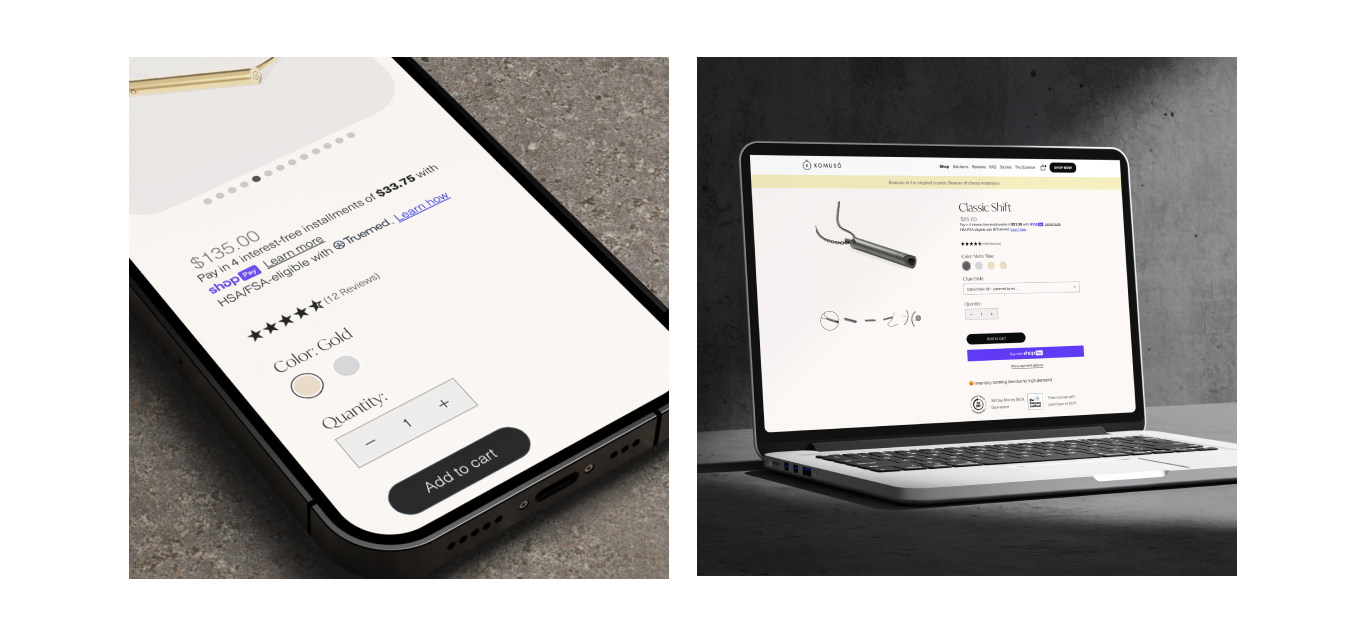Learn
Improving ‘Add to Cart’ Conversion Rate

Defining a CRO Process for Funnel Testing
As part of our website redesign for Komuso, creators of the Shift, a tool used to reverse stress by slowing your exhale, we conducted a full-funnel analysis to fully understand the user journey. Upon discovering a huge drop in the middle of the funnel, we were no longer breathing easy. Our team turned to funnel testing, informed by analytics, to sort out the kinks that could lead to improved CRO.
Services Provided
The Challenge
During our full-funnel audit of Komuso’s website, we identified a 96% drop-off from Product Detail Page (PDP) views to ‘Add to Cart’ for users that entered the site on a Product Page, which could lead to a significant loss in revenue. We needed to figure out what was causing such a significant drop in visitors — and hypothesize a conversion-boosting solution using funnel testing.
Our Approach
We assessed the Product Detail Page for the Classic Shift, Komuso’s top-selling breathing tool. The ‘Add to Cart’ feature received less visibility on this PDP page than other actions.

Our Strategy
1. Conduct a Stakeholder Interview
Guided by a series of questions known internally as a Discovery Brief, the Komuso and the Red Door team were able to align on key areas to focus on as part of the conversion funnel, and any nuances to consider when crafting the funnel analysis.
2. Identify Statistically-significant Differences
These could include user types, device types, journey stage, and other attributes for converting and non-converting paths.
3. Develop and Present a Testing Roadmap
It consists of the following elements per test: Hypothesis, Expected Duration, Estimated Sample Size, Target Segment, Testing Method (A/B vs. Multivariate, Multi-Page vs. Single Page, etc.), Expected Impact, Desired Confidence Level, and Measure of Success.
4. Conduct Each Test
Using the Testing Roadmap, we provide the Planning, Execution and Analysis to conduct each test while maintaining data integrity only long enough to derive statistically significant results.
5. Analyze Results
Once a test has either achieved the predetermined level of confidence or has run for the maximum acceptable duration to reasonably conclude a test had ‘no impact,’ we move to the Analysis portion of the test project.

The Solution
For this test, we assessed the Product Detail Page for the Classic Shift, Komuso’s top-selling breathing tool. On this PDP page, the ‘Add to Cart’ feature received less visibility than other actions on the page.
We hypothesized that if the ‘Add to Cart’ CTA was moved higher up on the page, and the product specs were shifted down, users would be more likely to add the Classic Shift to their shopping cart.


RESULTS
Upon completion of the one-week test, the variation with the CTA that’s included higher on the page had an 83% probability of being the best choice, and the ‘Add to Cart’ Conversion Rate had increased 24%.
Using data from the funnel analysis, if Komuso had implemented the changes from the recommended test in the given timeframe, they would have gained about 550 more purchases and $63,000 more in website revenue.